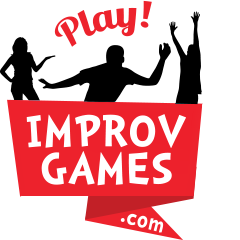Quick Description
 Audience members on stage are prompted to tell the players what to say. The audience members speak in a foreign language and the players say what they think the audience member said. Hint: Say what it sounds like. This is similar to the games Pillars and Teleprompter.
Audience members on stage are prompted to tell the players what to say. The audience members speak in a foreign language and the players say what they think the audience member said. Hint: Say what it sounds like. This is similar to the games Pillars and Teleprompter.
How to Play
Ask the audience who speaks a different language than the one spoken where you are.
Who speaks a different language from English (or the one we’re speaking now)?
Ask 2 or 3 of them to come to the stage. It may be helpful to reassure them that their part is pretty easy.
Explain to the audience volunteers that from time to time the players will tap them on the shoulder. That is the cue for the audience member to supply the dialogue for the players….in a foreign language. They players say what they thought the audience member said and continue the scene.
Player 1: (speaking to other player) Tom, I’ve been meaning to tell you that I want to…(taps audience volunteer on shoulder)
Audience volunteer: geef mijn bezittingen op en word een monnik
Player 1: hey my sitting is a wall neck.
Origins
I first saw this game at BATS Improv in San Francisco. It was set up by Laura Doorneweerd from Amsterdam. She adds, “it is a super fun game to celebrate the diversity of the audience.”
Notes
The players can set up easy sentences first. Ow wow, what is in this box, it is a…. And later make it more difficult. I will tell you what I think of this…
Consider having chairs for the audience volunteers to sit in instead of standing.
This game is very similar to Pillars and Teleprompter. [Which are not listed on this site, yet. Note to self. Write up these fun games so people can play them.]
This game is an anti narrative game because it interrupts and diverts any narrative continuity. And it’s pretty fun.
Get the The Playbook so you have hundreds of games in your pocket when you need them.
